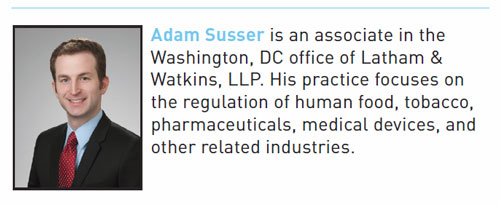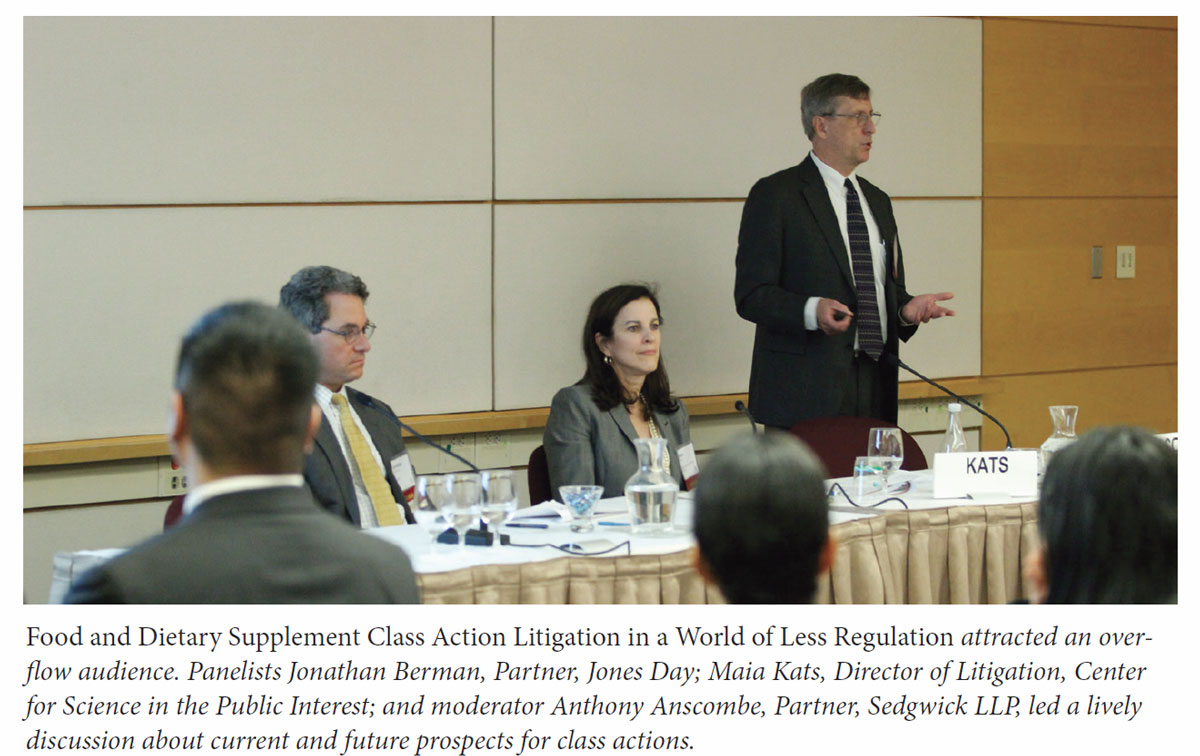
Food and Dietary Supplement Class Actions: Consumer Protection Against False and Misleading Marketing or Nuisance Litigation?
by Adam Susser
The intersection between U.S. Food and Drug Administration (FDA) regulation and food and dietary supplement class action litigation was a hot topic at a breakout session, “Food and Dietary Supplement Litigation in a World of Less Regulation,” on the first day of the 2017 FDLI Annual Conference. A diverse group of experts considered the current and future state of such litigation, in the context of the hostility to class action litigation and regulation emanating from Congress and the Trump Administration. The panel was comprised of Jonathan Berman, Partner, Jones Day, and Maia Kats, Director of Litigation, Center for Science in the Public Interest (CSPI), and was moderated by Anthony Anscombe, Partner, Sedgwick LLP.
Consumer Protection Against False and Misleading Marketing
 Anyone who has recently visited a Whole Foods, or other premium natural and organic supermarket, has experienced the ubiquity of “natural” and “kale” products currently available in stores. Indeed, an April 2016 nationally-representative telephone survey conducted by Consumer Reports indicated that 73% of consumers buy “natural” as opposed to “organic” food.1 Even so, according to data presented by Maia Kats at the breakout session, between 2015 and 2016, there was an observed 50% decline in litigation concerning “all natural” claims, likely attributable to the “all-natural” litigation that has already navigated the court system. By contrast, in the same period, there was an observed 100% increase in litigation concerning “health maintenance” claims (i.e., express or implied health claims). While these claims come in a variety of different forms, some common examples include: misleading health halos or false health claims (e.g., implying the presence of greater amounts of a characterizing ingredient than are actually present in the product), added sugar and protein (e.g., marketing a new version of a product that contains slightly more protein and seventeen times more sugar), and fortification of junk food (e.g., fortifying donuts with vitamins). In discussing these types of claims, Kats highlighted the role of CSPI in holding manufacturers and marketers accountable for their marketing claims.
Anyone who has recently visited a Whole Foods, or other premium natural and organic supermarket, has experienced the ubiquity of “natural” and “kale” products currently available in stores. Indeed, an April 2016 nationally-representative telephone survey conducted by Consumer Reports indicated that 73% of consumers buy “natural” as opposed to “organic” food.1 Even so, according to data presented by Maia Kats at the breakout session, between 2015 and 2016, there was an observed 50% decline in litigation concerning “all natural” claims, likely attributable to the “all-natural” litigation that has already navigated the court system. By contrast, in the same period, there was an observed 100% increase in litigation concerning “health maintenance” claims (i.e., express or implied health claims). While these claims come in a variety of different forms, some common examples include: misleading health halos or false health claims (e.g., implying the presence of greater amounts of a characterizing ingredient than are actually present in the product), added sugar and protein (e.g., marketing a new version of a product that contains slightly more protein and seventeen times more sugar), and fortification of junk food (e.g., fortifying donuts with vitamins). In discussing these types of claims, Kats highlighted the role of CSPI in holding manufacturers and marketers accountable for their marketing claims.
Recent actions brought by CSPI and others have focused on a subset of “kale products” that either contained less kale than implied by the use of kale as a characterizing ingredient on the product label or were less nutritious than advertised as a result of added sugar. Indeed, in October 2016, the CSPI filed a complaint in the U.S. District Court for the Eastern District of New York, alleging that PepsiCo. (Pepsi) marketed its Naked Juice line of beverages in a false and misleading manner, in violation of state consumer protection and unfair competition laws.2 For example, CSPI alleged that Naked’s Kale Blazer claimed to be comprised predominantly of kale “veggies” and “dark leafy goodness,” but was, in fact, made predominantly of sugary fruit juices, not dark leafy vegetables. Notably, the CSPI complaint specifically cited the Federal Food, Drug, and Cosmetic Act’s (FDCA’s) misbranding and false and misleading advertising provisions. In addition, the CSPI complaint cited FDA regulations prohibiting, among other things, true statements about ingredients that are misleading in light of the presence of other ingredients and naming foods to create an erroneous impression about the presence or absence of ingredient(s) or component(s) therein.3 In response to the lawsuit, Pepsi agreed to implement several significant changes to the labeling of its Naked juice products, such as the Kale Blazer, to make the labeling more transparent, including the addition of imagery that represents all main ingredients, and a disclaimer indicating that the juice is “Not a Low Calorie Food.”
In another example, CSPI undertook an investigation of allegedly misleading labeling in the infant and toddler foods industry in early 2015. As part of that effort, in May 2015, CSPI issued a demand letter to Plum Organics (Plum), a unit of Campbell Soup Company, asserting that Plum falsely and misleadingly labeled several products on their Principal Display Panels (PDP) as containing certain healthful ingredients, such as kale, quinoa, and blueberries, when, in fact, these products were overwhelmingly composed of other less healthful ingredients, such as apple juice or apple puree, that are not identified at all on the PDP for the products.4 Ultimately, CSPI entered into an agreement with Plum wherein Plum agreed to label its pouch products by the predominant ingredients. To illustrate, a product that has apple puree as the lead ingredient by weight, will be named “Apple Kale” as opposed to “Kale Quinoa.”5 Under the agreement, Plum also agreed to use imagery that reflected the same predominance principle.
These cases, among others, demonstrate that food and dietary supplement class actions can change the way products are marketed, increasing transparency and clarity for consumers. Since transparency is a foundational goal of the FDA’s nutrition labeling regulatory scheme, some stakeholders view food and dietary supplement class actions as providing additional enforcement resources for an overworked and understaffed regulatory agency.

Nuisance Litigation
The proliferation of food and dietary supplement class actions citing FDA regulations,6 policy statements and agency guidance,7 and scientific judgments8 has raised important questions regarding the agency’s core institutional competence. While the FDCA “statutory regime is designed primarily to protect the safety of the public at large,” the U.S. Supreme Court has recognized that “[t]he FDA, however, does not have the same perspective or expertise in assessing market dynamics” as “day-to-day competitors” whose “awareness of unfair competition practices may be far more immediate and accurate than that of agency rulemakers and regulators.” 9
Anthony Anscombe explored whether there is a disconnect between FDA regulatory actions (e.g., regulations, guidance, policy statements, etc.) and how those actions are used in litigation. Anscombe explained that food and dietary supplement class litigation focuses on consumer perceptions and has minimal relationship to FDA’s core public health mission. He noted that, by contrast, FDA regulations, interpretations, and position statements frequently turn on legal interpretations and policy judgments, as opposed to empirical evidence concerning how consumers perceive a product or the “materiality” of this perception to a consumer’s purchasing decision. To illustrate, Anscombe discussed FDA’s May 2016 guidance, which declared that use of the term “evaporated cane juice” is false and misleading under Section 403(a)(1) of the FDCA.10 FDA based its determination, expounded in the evaporated cane juice guidance, on: (a) FDA regulatory definitions of the terms “juice”11 and “sugar;”12 (b) expert views of fruits and vegetables;13 and (c) the Codex Alimentarius standard for sugars.14 Notably, FDA did not base its determination on analysis of consumer understanding of the term “evaporated cane juice” or the materiality of the presence of the term on a product label to consumer purchasing decisions.
Using FDA’s evaporated cane juice guidance as a case study, Anscombe argued that FDA’s determination that a product label is “false and misleading” under Section 403(a)(1) of the FDCA does not necessarily mean that a particular label claim is deceptive under state unfair competition laws and consumer fraud acts. Courts interpreting such FDA actions, in the context of food and dietary supplement class action litigation, may be likely to perform a rigorous analysis regarding the level of deference, if any, accorded to FDA’s position.15 To that end, courts may evaluate FDA’s regulatory process, the weight given to its own statements, and how well FDA’s analysis tracks consumer experience generally. In addition, the Trump Administration may impose additional constraints on FDA when taking regulatory actions. For example, the 2-for-1 Executive Order16 directs all executive agencies, including FDA, to identify at least two existing regulations to be repealed, unless prohibited by law, for each notice of proposed rulemaking. Moreover, agency leadership appears to be sensitive to the implications of FDA regulatory actions in private litigation.
Jonathan Berman traced the growth of food and dietary supplement class action litigation to a case brought against Dannon Co. (Dannon), alleging that Dannon falsely marketed and advertised the purported health benefits of its Activia and DanActive yogurt products.17 The case resulted in a $35 million settlement agreement, which birthed a succession of lawsuits brought by members of the plaintiff’s bar. While the Dannon case is viewed by many in industry as opening the class litigation floodgates, recent cases have settled for significantly lower dollar amounts (i.e., below $10 million), which may decrease the attractiveness of bringing these cases in the future. In the event that a company faces such a class action, key defenses include both procedural arguments at the class certification stage (i.e., no common proof of injury or damages) and substantive arguments on the merits (i.e., no deception).
A recent California Superior Court case demonstrates that it is possible for companies to litigate, and win, these types of class actions. In Garrett v. Bumble Bee Foods, Inc., plaintiffs filed a class action on behalf of themselves and a putative class of California consumers who purchased Bumble Bee Food, Inc.’s (Bumble Bee’s) tuna products between 2008-2014, asserting, among other things, violations of California’s unfair competition and false advertising laws. The crux of the plaintiffs’ claim was that Bumble Bee “made false, misleading and deceptive claims on its labels for tuna products (specifically Albacore Tuna in Water) by representing that its products were an ‘excellent source’ of Omega 3[,]” even though there was no established recommended daily intake, and “by using the American Heart Association (‘AHA’) heart check logo without disclosing” the allegedly material fact that it was a paid endorsement.18 The plaintiffs argued that Bumble Bee’s use of the “excellent source” claim in 2007 directly contradicted FDA’s November 2007 Advance Notice of Proposed Rulemaking (ANPRM) concerning nutrient content claims for Omega 3.
After a bench trial, California Superior Court Judge Peter H. Kirwan concluded that the plaintiffs “failed to meet their burden in establishing that Bumble Bee’s use of the ‘excellent source’ claim and the AHA heart check logo was in violation of the Unfair Competition Law.” While the Court agreed that, in 2007, use of the “excellent source” claim contradicted FDA’s stated position in its 2007 ANPRM, the court explained that the fact that Bumble Bee engaged in conduct that was proscribed by a proposed rule does not necessarily make it unlawful or illegal. Further, Judge Kirwan explained that Bumble Bee should not be precluded from relying upon the FDA’s allowance of a competitor’s nutrient content claim notification simply because they did not submit their own notification. Additionally, the court rejected the plaintiff’s claim regarding use of the AHA heart check logo because “the Plaintiffs did not provide evidence that the payment of a fee automatically entitled Bumble Bee to use the logo.”19 Thus, the case suggests that, with the right facts, it is possible to both try and win these types of cases, even in the face of apparently contradictory FDA regulatory actions.
The Future of Food and Dietary Supplement Class Actions
The industry’s ongoing frustration with litigation that it believes exclusively benefits plaintiffs’ lawyers, as opposed to the general public, has created the impetus for congressional action to curb the perceived abuses. With that in mind, panelists addressed a piece of proposed legislation that has been percolating in the U.S. House of Representatives, H.R. 985, the “Fairness in Class Action Litigation and Further Asbestos Claim Transparency Act of 2017.”20 The bill would make several changes to the operation of class action litigation in federal courts, such as: imposing more stringent ascertainability requirements; linking attorney’s fees to class recovery; granting an automatic stay of discovery during the pendency of any motions to dismiss and certain other motions; and granting an automatic appeal of all class certification decisions.21 While H.R. 985 would impose limits on class action litigation in federal court, observers note that this proposed legislation may also result in unintended consequences. Specifically, if H.R. 985 is enacted as currently written, there is a possibility of increased numbers of state class actions, especially given the increase in states that have enacted “private attorney general” statutes. Thus, although Congress may take steps designed to limit such litigation, in the end, these efforts are likely to make only marginal changes.
In sum, while it is possible that congressional action may address certain perceived abuses of class action litigation in federal courts, food and dietary supplement class action litigation, in some form, is likely here to stay. Public interest groups and the plaintiffs’ bar will continue to pursue cases in state and federal courts in which they allege that companies utilize false and misleading marketing claims, citing FDA regulatory actions where such actions support their cause. As a result, it is incumbent on the compliance and legal departments within companies to proactively ensure that product labeling and advertising messages are not false and misleading and comply with relevant FDA regulations and policies.
- Consumer Reports National Research Center, Food Labels Survey: 2016 Nationally-Representative Phone Survey (Apr. 6, 2016), http://www.consumerreports.org/content/dam/cro/news_articles/health/PDFs/ConsumerReports-Food-Labels-Survey-April-2016.pdf (last visited May 17, 2017).
- See Complaint, Lipkind. v. Pepsico, Inc. No. 1:16-cv-05506 (Oct. 4, 2016), https://cspinet.org/sites/default/files/attachment/001%20Complaint.pdf (last visited May 17, 2017).
- Id. (citing, 21 C.F.R. §§ 101.18(b); 102.5(c)).
- Center for Science in the Public Interest, Letter from Maia Kats, Director of Litigation, Re: Deceptive trade practices in marketing and sale of certain “Plum Organics” brand food products for babies and toddlers (May 11, 2015), https://cspinet.org/sites/default/files/attachment/plum-letter-5-11-15.pdf (last visited May 17, 2017).
- See Letter Agreement re: Plum Pouched Products and Mighty Bars (Oct. 21, 2015), https://cspinet.org/sites/default/files/attachment/Final%20Executed%20Settlement%20Agreement%20102115.pdf (last visited May 17, 2017).
- See e.g., 21 C.F.R. §§ 161.190 (tuna fill); 100.100 (slack fill); 101.65 (healthy).
- See e.g., FDA, Guidance for Industry: Ingredients Declared as Evaporated Cane Juice (May 2016), https://www.fda.gov/downloads/Food/GuidanceRegulation/GuidanceDocumentsRegulatoryInformation/UCM502679.pdf (last visited May 17, 2017) (hereafter “Evaporated Cane Juice Guidance”); Food Labeling Nutrient Content Claims; General Principles, Petitions, Definitions of Terms, 56 Fed. Reg. 60421, 60466 (Proposed Nov. 27, 1991) (discussing FDA’s informal policy re: natural).
- See e.g., Food Labeling: Revision of the Nutrition and Supplement Facts Labels, 81 Fed. Reg. 33742 (May 27, 2016) (added sugars); Food Labeling: Trans Fatty Acids in Nutrition Labeling, Nutrient Content Claims, and Health Claims, 68 Fed. Reg. 41434 (July 11, 2003) (trans fats).
- Pom Wonderful LLC v. Coca-Cola Co., 134 S.Ct. 2228, 2234-35 (2014).
- See Evaporated Cane Juice Guidance (citing 21 U.S.C. § 343(a)(1)).
- Id. (citing 21 C.F.R. § 120.1(a)).
- Id. (citing 21 C.F.R. § 184.1854).
- See e.g., Id. (citing, among other experts, the U.S. Department of Agriculture’s Center for Food Policy and Promotion listing of “cane juice” and “sugar cane juice” among the many names for added sugars on its guidance).
- Id. (citing Codex Standard for Sugars. Codex Standard 212-1999, Adopted 1999, Amendment 2001, http://www.fao.org/input/download/standards/338/CXS_212e_u.pdf (last visited May 17, 2017)).
- Pom Wonderful LLC v. Coca-Cola Co., 134 S.Ct. 2228 (2014) (holding that the FDCA does not preclude a private party from bringing a Lanham Act claim challenging a misleading food label that is regulated by the FDCA).
- Exec. Order. No. 1331, Presidential Executive Order on Reducing Regulation and Controlling Regulatory Costs, 82 Fed. Reg. 9339 (Feb. 3, 2017).
- Gemelas v. The Dannon Co. Inc., No. 1:08-cv-00236 (N.D. Ohio Sept. 18, 2009).
- Proposed Statement of Decision, Garrett et al. v. Bumble Bee Foods LLC, Case No. 2014-1-cv-264322 (Sup. Ct. Cal. Mar. 30, 2017).
- Id.
- Fairness in Class Action Litigation and Furthering Asbestos Claim Transparency Act of 2017, H.R. 985, 115th Cong. (2017), available at https://www.congress.gov/115/bills/hr985/BILLS-115hr985rfs.pdf (last visited May 17, 2017).
- Id. at §§ 1716 (ascertainability of class members); 1718 (attorney’s fees); 1721 (stay of discovery); 1723 (appeals).
Update Magazine
May/June 2017








